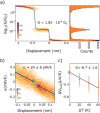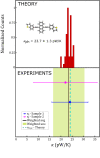Full thermoelectric characterization of a single molecule
- PMID: 37391406
- PMCID: PMC10313753
- DOI: 10.1038/s41467-023-39368-7
Full thermoelectric characterization of a single molecule
Abstract
Molecules are predicted to be chemically tunable towards high thermoelectric efficiencies and they could outperform existing materials in the field of energy conversion. However, their capabilities at the more technologically relevant temperature of 300 K are yet to be demonstrated. A possible reason could be the lack of a comprehensive technique able to measure the thermal and (thermo)electrical properties, including the role of phonon conduction. Here, by combining the break junction technique with a suspended heat-flux sensor, we measured the total thermal and electrical conductance of a single molecule, at room temperature, together with its Seebeck coefficient. We used this method to extract the figure of merit zT of a tailor-made oligo(phenyleneethynylene)-9,10-anthracenyl molecule with dihydrobenzo[b]thiophene anchoring groups (DHBT-OPE3-An), bridged between gold electrodes. The result is in excellent agreement with predictions from density functional theory and molecular dynamics. This work represents the first measurement, within the same setup, of experimental zT of a single molecule at room temperature and opens new opportunities for the screening of several possible molecules in the light of future thermoelectric applications. The protocol is verified using SAc-OPE3, for which individual measurements for its transport properties exist in the literature.
© 2023. The Author(s).
Conflict of interest statement
The authors declare no competing interests.
Figures



References
-
- Gotsmann B, Gemma A, Segal D. Quantum phonon transport through channels and molecules—a perspective. Appl. Phys. Lett. 2022;120:160503. doi: 10.1063/5.0088460. - DOI
-
- Cui L, Miao R, Jiang C, Meyhofer E, Reddy P. Perspective: Thermal and thermoelectric transport in molecular junctions. J. Chem. Phys. 2017;146:092201. doi: 10.1063/1.4976982. - DOI
-
- Tao, N. J. Electron transport in molecular junctions. Nanosci. Technol. 185–193, 10.1142/9789814287005_0019 (2009).
Grants and funding
- 767187/EC | Horizon 2020 Framework Programme (EU Framework Programme for Research and Innovation H2020)
- 766853/EC | Horizon 2020 Framework Programme (EU Framework Programme for Research and Innovation H2020)
- 200660/Swiss National Science Foundation | National Center of Competence in Research Quantum Science and Technology (NCCR "QSIT - Quantum Science and Technology")
LinkOut - more resources
Full Text Sources

